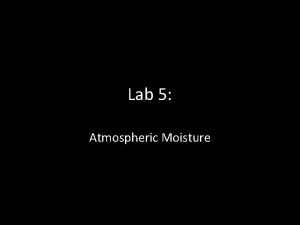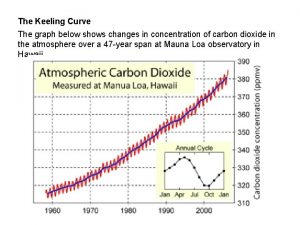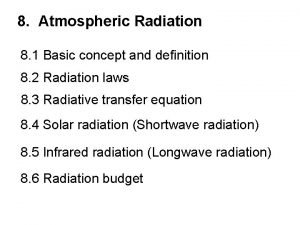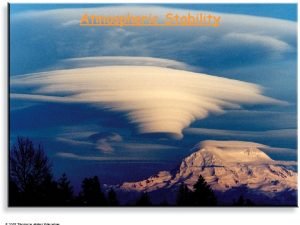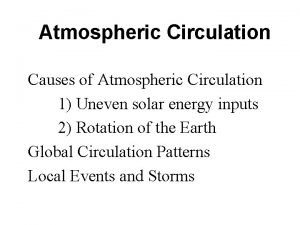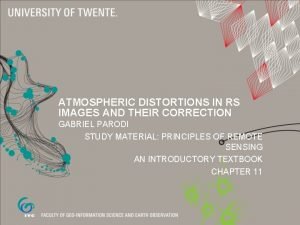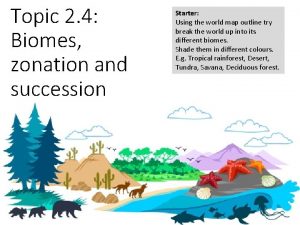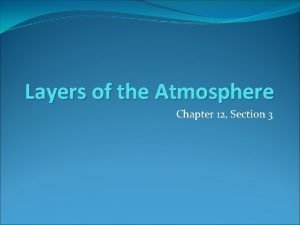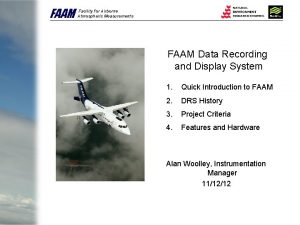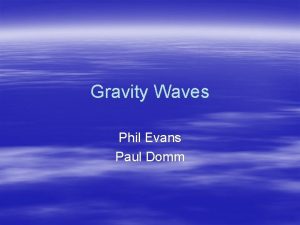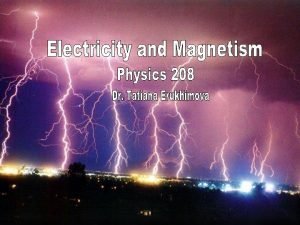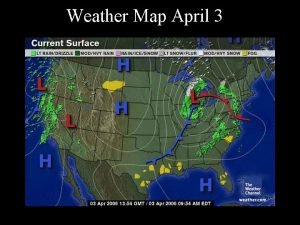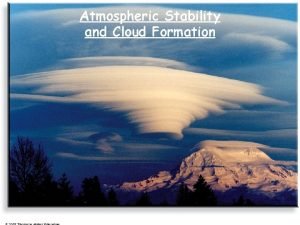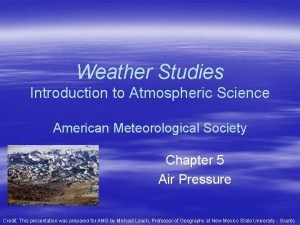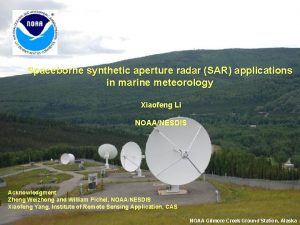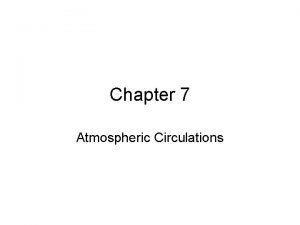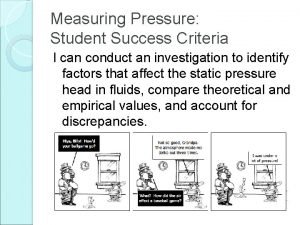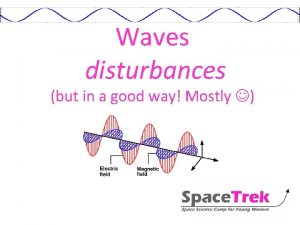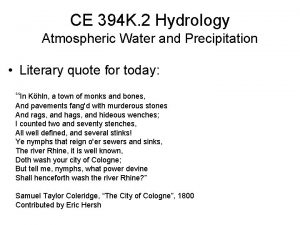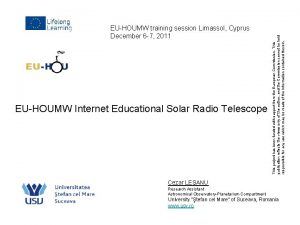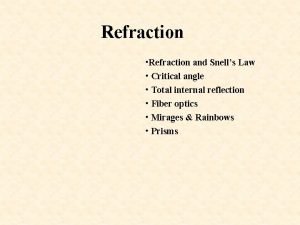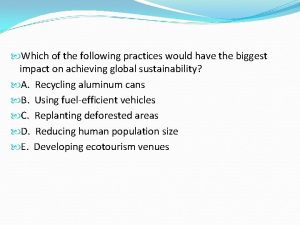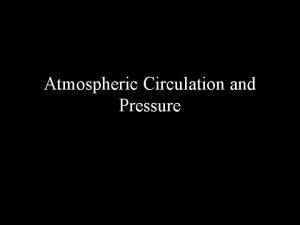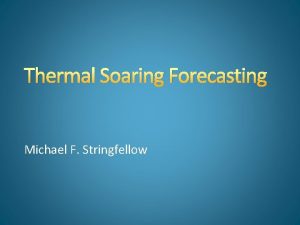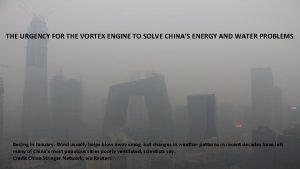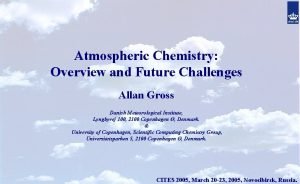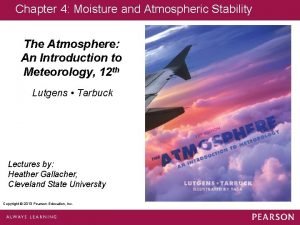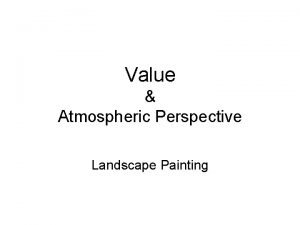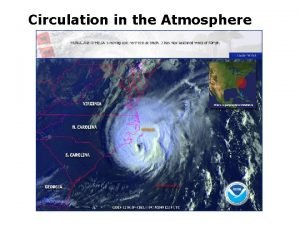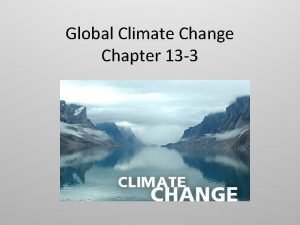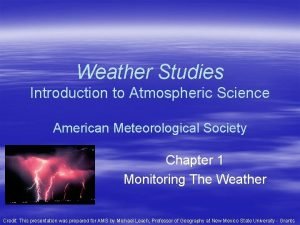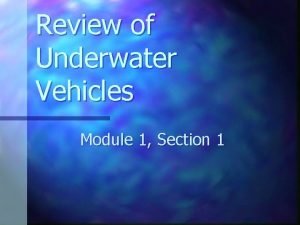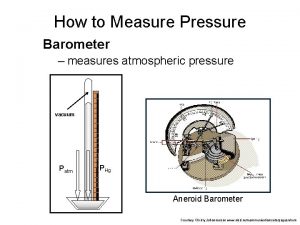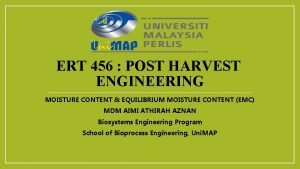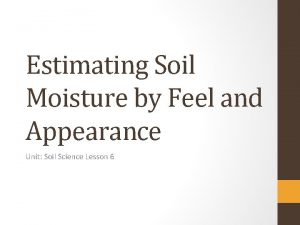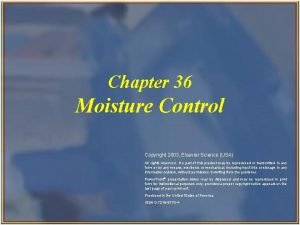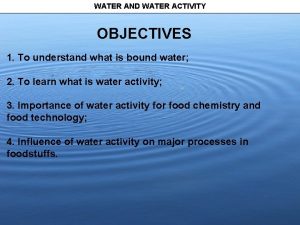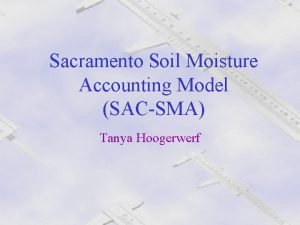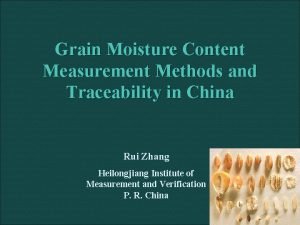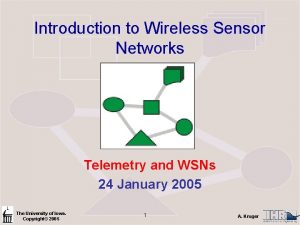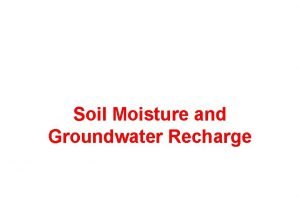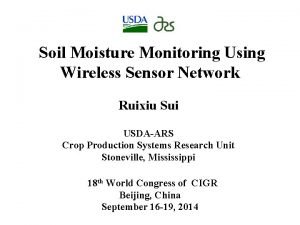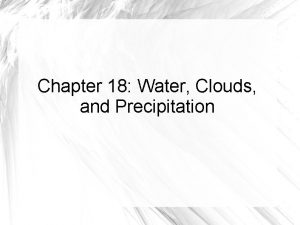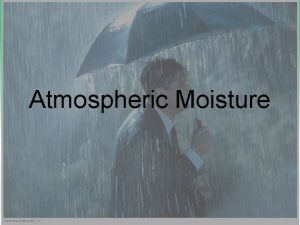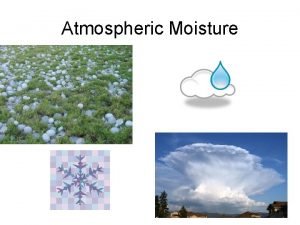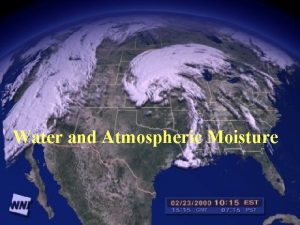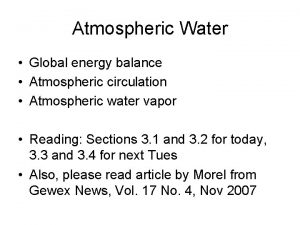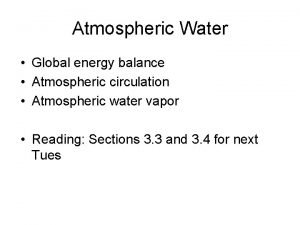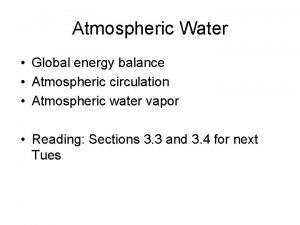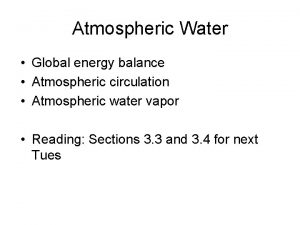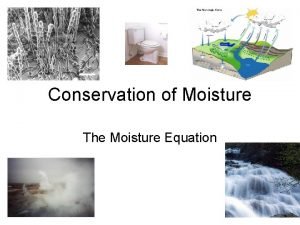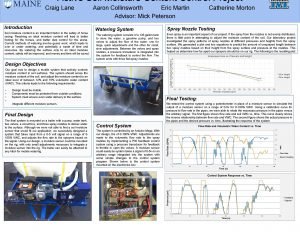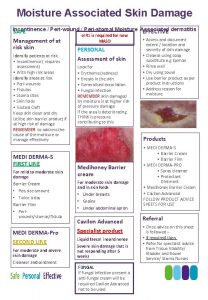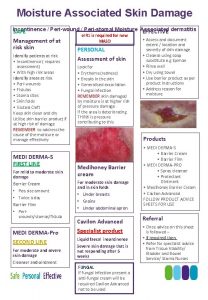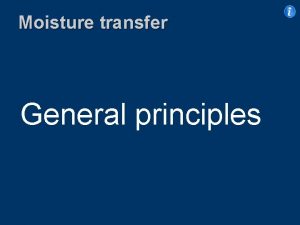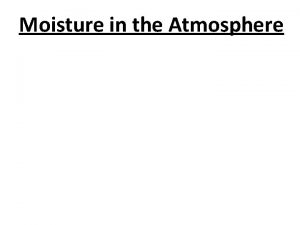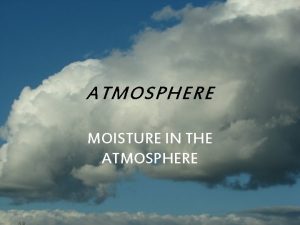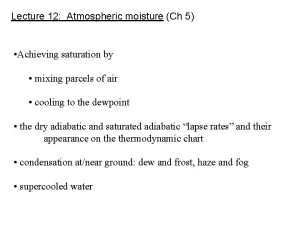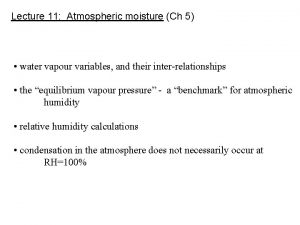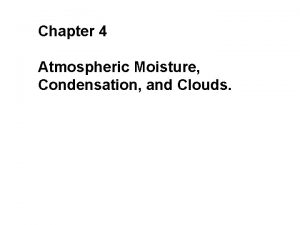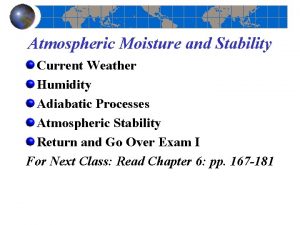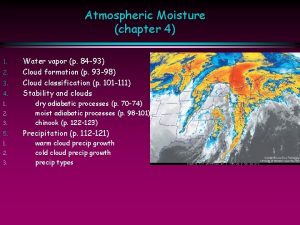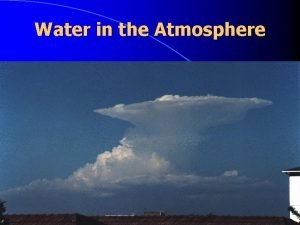Ch 6 Atmospheric Moisture Ch 6 Atmospheric Moisture





























































- Slides: 61


Ch 6 – Atmospheric Moisture

Ch 6 – Atmospheric Moisture • Introduction – In Chapter 1, we learned that water vapor is a variable gas, occupying only a small percentage of the volume of the gases in the atmosphere. – Although water vapor is around us in only small quantities, it has major consequences, not the least of which include icing, thunderstorms, freezing rain, downbursts, whiteouts, frost, and lightning (Lester, 2006).

Ch 6 – Atmospheric Moisture • Introduction – In this chapter, we look at the basics of atmospheric moisture, a term which is used here to imply the presence of H 2 O in any one or all of its states: water vapor, water, or ice. – We examine the transformation between states and the importance of air temperature in the transformation process. – When you complete this chapter, you will understand the causes and effects of state changes, how clouds form and dissipate, and how precipitation is produced (Lester, 2006).

Ch 6 – Atmospheric Moisture • Introduction – You will also know how clouds and precipitation are classified and observed (Lester, 2006).

Ch 6 – Atmospheric Moisture • Section A – Moisture Characteristics – State Changes – Vapor Pressure – Relative Humidity – Dewpoint Temperature

Ch 6 – Atmospheric Moisture • Section B – Clouds – Cloud Formation • Water Vapor • Condensation Nuclei • Cooling • Latent Heat and Stability – Cloud and Visibility Observations • Standard Cloud Observations • Visibility • Cloud Type • Other Useful Cloud Observations

Ch 6 – Atmospheric Moisture • Section C – Precipitation Causes – Precipitation Characteristics • Types • Intensity and Amount – METAR – Hydrologic Cycle

Ch 6 – Atmospheric Moisture • Section A: Moisture Characteristics – State Changes • Water vapor – is a colorless, odorless, tastless gas in which the molecules are free to move about, as in any gas • Water – in the liquid state (water), molecules are restricted in their movements in comparison to water vapor at the same temperature • Ice – as a solid ice, the molecular structure is even more rigid and the freedom of movement is greatly restricted


Ch 6 – Atmospheric Moisture • Change of state – refers to the transition from one form of H 2 O to another

Ch 6 – Atmospheric Moisture • ***The processes by which water vapor is added to unsaturated air are evaporation and sublimation

Ch 6 – Atmospheric Moisture • Change of state – refers to the transition from one form of H 2 O to another – Melting – ice to water – Evaporation – water to vapor – Sublimation – ice directly to vapor without water as an intermediate state; figure 6 -1 – Condensation – vapor to water – Freezing – water to ice – Deposition – vapor directly to ice without water as an intermediate state – Latent heat – the amount of heat energy that is absorbed or released when H 2 O changes from one state to another – Sensible heat – heat that can be felt and measured when the molecules pass to lower energy states

Ch 6 – Atmospheric Moisture • Vapor Pressure – Partial pressure – in the mixture of atmospheric gases, each individual gas exerts a partial pressure. Vapor pressure (VP) – the partial pressure exerted by water vapor (H 2 O in gaseous form) – Saturation – occurs when the same amount of molecules are leaving a water surface as are returning – Saturation vapor pressure (SVP) – figure 6 -2; the vapor pressure exerted by the molecules of water vapor in this equilibrium condition


Ch 6 – Atmospheric Moisture • ***The amount of water vapor needed to saturate the air largely depends on air temperature

Ch 6 – Atmospheric Moisture • Boiling – occurs when SVP equals the total air pressure

Ch 6 – Atmospheric Moisture • Relative Humidity – it is often useful to determine how close the atmosphere is to saturation – this information can help you anticipate the formation of clouds or fog – this is done by measuring the amount of water vapor in the atmosphere in terms of actual VP and then estimating SVP from a temperature measurement; figure 6 -3 – the degree of saturation is then computed by taking the ratio of VP and SVP and multiplying it by 100 – the result is called relative humidity – it expresses the amount of water vapor actually in the air as a percentage of the amount required for saturation • RH (%) = (VP/SVP) x 100

Ch 6 – Atmospheric Moisture • Dewpoint Temperature – Dewpoint – the temperature at which condensation first occurs when air is cooled at a constant pressure without adding or removing water vapor • dew point temperature is always less than the air temperature, with one exception – when the air is saturated (RH = 100%), the temperature and dew point are equal

Ch 6 – Atmospheric Moisture • ***Dew point refers to the temperature to which air must be cooled to become saturated

Ch 6 – Atmospheric Moisture • Temperature-Dew point Spread – a very useful quantity that relates RH and dew point – also called the dew point depression – it is the difference between the air temperature and dew point • when the temperature-dew point spread is small, the RH is high • when the spread is very large, the RH is low; figure 6 -4

Ch 6 – Atmospheric Moisture • Dew – a condensation product that forms when the ground or other object (such as the wings of a parked airplane) loses heat energy through night time (nocturnal) radiation

Ch 6 – Atmospheric Moisture • White dew – if the temperature falls below 32 degrees F (0 degrees C) after dew is present, it will freeze

Ch 6 – Atmospheric Moisture • ***Frost forms when the temperature of the collecting surface is at or below the dew point of the adjacent air and the dew point is below freezing – Frost is considered hazardous to flight because it spoils the smooth flow of air over the wings, thereby decreasing lifting capability

Ch 6 – Atmospheric Moisture • Section B: Clouds - suspension of water droplets and / or ice crystals in the atmosphere – Cloud Formation - three requirements for cloud formation are water vapor, condensation nuclei and cooling – Water Vapor - cloud development requires adequate water vapor • cloud formation favored in air with high RH (small temperature dew point spread)

Ch 6 – Atmospheric Moisture – Condensation Nuclei - Condensation Nuclei are microscopic particles such as dust and salt that provide surfaces on which water vapor undergoes condensation to form water droplets or deposition to form ice crystals • fog is usually more prevalent in industrial areas because of an abundance of condensation nuclei

Ch 6 – Atmospheric Moisture • ***Fog is usually more prevalent in industrial areas because of an abundance of condensation nuclei from combustion

Ch 6 – Atmospheric Moisture • Cooling -contact cooling, advection fog often forms in coastal areas – conditions favorable for the formation of radiation fog over a land surface are clear skies, little or no wind, and a small temperature-dew point spread – if the fog is very shallow (less than 20 feet deep) it is called ground fog – valley fog forms when radiational cooling causes cool dense air to pool in a valley – river valleys with ample supplied of moisture are favorable locations for this type of fog – rain shadow; upslope fog – the types of fog that depend on wind in order to exist are advection fog and upslope fog – steam fog is common over unfrozen water bodies in the cold months of the year



Ch 6 – Atmospheric Moisture • ***Advection fog often forms in coastal areas • ***Conditions favorable for the formation of • radiation fog over a land surface are clear skies, little or no wind a small temperature-dew point spread ***The types of fog that depend upon wind in order to exist are advection fog and upslope fog

Ch 6 – Atmospheric Moisture • Latent Heat and Stability -saturated adiabatic process – saturated adiabatic lapse rate (SALR) • varies between 3 C per 1, 000 ft for very cold temperatures and 1 C per 1, 000 ft for very hot temperatures • condensation level • conditional instability – air parcel must become saturated in order to be unstable


Ch 6 – Atmospheric Moisture • Cloud and Visibility Observations -learning to observe clouds and visibility is essential for proper interpretation of METAR and for flight safety – Standard Cloud Observations - sky condition • cloud height, cloud amount, cloud type

Ch 6 – Atmospheric Moisture – Visibility • tower visibility • prevailing visibility • runway visibility (RVV) • runway visual range (RVR)

Ch 6 – Atmospheric Moisture – VFR conditions • VFR: ceiling > 3, 000 ft AGL and visibility > 5 sm • MVFR: ceiling 1, 000 to 3, 000 ft AGL and / or visibility 3 to 5 sm • IFR conditions – IFR: ceiling 500 to < 1, 000 ft AGL and/or visibility 1 to < 3 sm – LIFR: ceiling <500 feet AGL and / or visibility < 1 sm

Ch 6 – Atmospheric Moisture • ***A ceiling is defined as the height above the earth’s surface of the lowest layer reported as broken or overcast, or as the vertical visibility into an indefinite ceiling


Ch 6 – Atmospheric Moisture • Cloud Type - ten basic cloud types < 6500 feet AGL – low (ST) Stratus – (SC) Stratocumulus – (NS) Nimbostratus • 6, 500 to 20, 000 ft AGL – Middle (AC) Altocumulus – (AS) Altostratus, High > 20, 000 ft AGL – (CC) Cirrocumulus – (CS) Cirrostratus – (CI) Cirrus – Clouds with vertical development (CU) Cumulus – (CB) Cumulonimbus

Ch 6 – Atmospheric Moisture • the four families of clouds are high, middle, low and • • those with extensive vertical development – a high cloud is composed mostly of ice crystals the stability of the air before lifting occurs determines the structure or type of clouds which form as a result of air being forced to ascend heights of cumulus cloud bases can be determined by H = (T – DP) / 4. 4 – Cloud Height – cloud layer, cloud height

Ch 6 – Atmospheric Moisture • Fog – vertical visibility (VV) or indefinite ceiling is the vertical distance that an observer or remote sensing device on the ground can see into a low cloud or other obscuring phenomenon – cloud height is the height of the base of the cloud above the ground – when sky is completely obscured the reported cloud height is actually the vertical visibility


Ch 6 – Atmospheric Moisture • Cloud Amount – amount of sky covered by each cloud layer – celestial dome – clear (SKC) – no clouds present – clear (CLR) – no clouds below 12, 000 ft AGL – few (FEW) – 1/8 to 2/8 sky cover – scattered (SCT) – 3/8 to 4/8 coverage – broken (BKN) – 5/8 to 7/8 coverage – overcast (OVC) – 8/8 coverage


Ch 6 – Atmospheric Moisture • Obscurations and ceilings – obscuration, ceiling, indefinite ceiling, vertical visibility – a ceiling is defined as the height above the earth’s surface of the lowest layer reported as broken or overcast, or as the vertical visibility into an indefinite ceiling • PIREPS pilot’s reports

Ch 6 – Atmospheric Moisture • ***The four families of clouds are high, middle, • • low and those with extensive vertical development ***A high cloud is composed mostly of ice crystals ***The stability of the air before lifting occurs determines the structure or type of clouds which form as a result of air being forced to ascend

Ch 6 – Atmospheric Moisture • Other Useful Cloud Observations - satellite images from the Geostationary Orbiting Environmental Satellite (GOES)

Ch 6 – Atmospheric Moisture • Section C: Precipitation – Precipitation Causes • condensation / deposition • collision / coalescence – large droplets fall faster than smaller particles capturing them as they descend • ice crystal process • super cooled water droplets are primary cause of aircraft icing • ice crystals grow at the expense of super cooled water droplets in the ice crystal process


Ch 6 – Atmospheric Moisture • Precipitation Characteristics – Types • Drizzle • Rain • rain showers • freezing drizzle • freezing rain • black ice • the presence of ice pellets at the surface is evidence that there may be freezing rain at a higher altitude – ice pellets • Snow • snow showers • Virga • fall streaks



Ch 6 – Atmospheric Moisture • ***The presence of ice pellets at the surface is evidence that there may be freezing rain at a higher altitude

Ch 6 – Atmospheric Moisture • Intensity and Amount – drizzle or snowfall intensity and associated visibility • light > ½ • moderate > ¼ but < or = ½ • Heavy < or = ¼ • snow depth – heavy snow warning vblizzard


Ch 6 – Atmospheric Moisture • METAR – – METAR format; Figure 6 -27 page 6 -27 Visibility – reported in statute miles Present Weather intensity symbols • light (-) • moderate (no sign) • or heavy (+) • Proximity • descriptor; see Figure 6 -28 page 6 -28; list of contractions for various weather phenomena; see Figure 6 -29 page 6 -29


Ch 6 – Atmospheric Moisture • Hydrologic Cycle – on and below the surface of the earth, moisture is stored as ice and snow, and as water in lakes, rivers, ground water and the oceans – water vapor removed from the earth’s surface may be transported far from its source by the wind – clouds form and produce precipitation that returns the moisture to the earth’s surface.

Summary • You have learned some important details about H 2 O and its three states in the atmosphere. • Changes of state and the associated latent heat exchanges have important effects on cloud formation and dissipation and on atmospheric stability (Lester, 2006).

Summary • You should now understand that there are important differences between the way clouds are formed and the processes by which precipitation is produced. • On the very practical side, you should know the basic elements of cloud and precipitation observing and reporting (Lester, 2006).

Summary • Your ability to recognize the 10 basic cloud types • and the types and characteristics of precipitation give you valuable observational tools which will help you evaluate the state of the atmosphere and its likely effect on flight. In the next chapter, you will apply your knowledge of all of the basic physical processes gained thus far to understand how atmospheric storms and other circulations arise, and to determine their structures and future behavior (Lester, 2006).
 Lab 5 atmospheric moisture
Lab 5 atmospheric moisture The graph below shows atmospheric carbon dioxide
The graph below shows atmospheric carbon dioxide Atmospheric
Atmospheric Unstable equilibrium definition
Unstable equilibrium definition Atmospheric suits
Atmospheric suits Atmospheric convection
Atmospheric convection Atmospheric distortion correction
Atmospheric distortion correction Tri cellular model of atmospheric circulation upsc
Tri cellular model of atmospheric circulation upsc Section 1 atmospheric basics continued answers
Section 1 atmospheric basics continued answers Lightning elves
Lightning elves Facility for airborne atmospheric measurements
Facility for airborne atmospheric measurements Atmospheric gravity waves
Atmospheric gravity waves Dr tatiana erukhimova
Dr tatiana erukhimova Atmospheric pressure in complete denture
Atmospheric pressure in complete denture Usairnet temperature map
Usairnet temperature map What is low pressure
What is low pressure Conditionally unstable atmosphere
Conditionally unstable atmosphere Weather studies introduction to atmospheric science
Weather studies introduction to atmospheric science Atmospheric gravity waves
Atmospheric gravity waves Atmospheric weather variables
Atmospheric weather variables Atmospheric vortex engine
Atmospheric vortex engine Atmospheric refraction
Atmospheric refraction Single cell model of atmospheric circulation
Single cell model of atmospheric circulation Static head formula
Static head formula Atmospheric opacity
Atmospheric opacity Atmospheric convection
Atmospheric convection Atmospheric opacity
Atmospheric opacity Collage about the different atmospheric optics events
Collage about the different atmospheric optics events Atmospheric chemistry suite
Atmospheric chemistry suite Starlings displacing bluebirds from nesting sites
Starlings displacing bluebirds from nesting sites Single cell model of atmospheric circulation
Single cell model of atmospheric circulation Regional atmospheric soaring prediction
Regional atmospheric soaring prediction Penn state meteorology certificate
Penn state meteorology certificate Earths layers definition
Earths layers definition Atmospheric vortex engine
Atmospheric vortex engine Atmospheric reaction
Atmospheric reaction Atmospheric stability
Atmospheric stability Atmospheric perspective landscape
Atmospheric perspective landscape Atmospheric convection
Atmospheric convection Atmospheric circulation
Atmospheric circulation Atmospheric physics lecture notes
Atmospheric physics lecture notes Global warming
Global warming American meteorological society
American meteorological society Stellar heaven
Stellar heaven Atmospheric diving suit
Atmospheric diving suit Atmospheric pressure
Atmospheric pressure Pressure at different altitudes
Pressure at different altitudes Apes unit 2
Apes unit 2 Equilibrium moisture content definition
Equilibrium moisture content definition Wisemini
Wisemini Estimating soil moisture by feel and appearance
Estimating soil moisture by feel and appearance Rate of drying formula
Rate of drying formula Chapter 36 moisture control
Chapter 36 moisture control What is water
What is water Sac-sma
Sac-sma Grain moisture content measurement
Grain moisture content measurement Taxis and kinesis in animals
Taxis and kinesis in animals Aten
Aten Soil moisture meter argos
Soil moisture meter argos Soil moisture introduction
Soil moisture introduction Soil moisture sensor
Soil moisture sensor Love of cloud and rain chapter 18
Love of cloud and rain chapter 18
